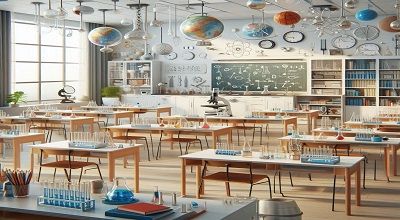Science Classroom Design
The Science of Classroom Design is a topic that explores how the physical characteristics of a learning space can affect student learning outcomes. Some of the factors that are considered in this topic are lighting, ventilation, air quality, furniture layout, wall decorations, and ambient noise. Research has shown that good classroom design can improve the academic performance, engagement, attention, and well-being of students.
Some Examples of Good Science Classroom design
Some examples of good classroom design are:
- Table Groups Layout: This layout involves arranging tables in groups to facilitate social interaction and collaborative learning. It is ideal for hands-on and project-based activities, but it can also be noisy and hard to manage.
- Telefonplan School by Vittra: This school in Sweden has no traditional classrooms, but instead has open spaces with different themes, such as the cave, the campfire, the show-off, the laboratory, and the watering hole. These spaces are designed to stimulate different types of learning, such as quiet reflection, group discussion, presentation, experimentation, and socialization.
- Innova Design Group’s Classrooms: This company specializes in creating innovative learning environments that make use of space and technology. Some of their projects include a science lab with flexible furniture and interactive whiteboards, a music room with acoustic panels and soundproof booths, and a drama studio with a stage and lighting system.
- The Science of Classroom Design Infographic: This infographic summarizes some of the research findings on how classroom design affects student learning outcomes. It covers aspects such as lighting, ventilation, air quality, furniture layout, wall decorations, and ambient noise. It also provides some tips and best practices for creating a conducive learning space.
Create a Good Learning Environment in the Classroom
Creating a good learning environment in your classroom is important for both you and your students. A positive learning environment can help students feel safe, valued, respected, motivated, and engaged in their learning. It can also help you as a teacher to enjoy your work and avoid burnout.
There are many strategies that you can use to create a good learning environment in your classroom, such as:
- Building positive relationships with your students and colleagues. You can do this by showing interest in their lives, listening to their needs and concerns, giving feedback and praise, and being supportive and respectful.
- Arranging the physical environment of your classroom to make it comfortable, accessible, and stimulating. You can do this by choosing appropriate furniture, lighting, temperature, noise level, and decorations. You can also use different seating arrangements, such as groups, pairs, or circles, to facilitate interaction and collaboration.
- Setting high academic expectations for your students and yourself. You can do this by communicating your course goals and learning objectives clearly, providing challenging and relevant tasks and activities, and encouraging students to take responsibility for their own learning and progress.
- – Providing positive reinforcement for your students’ efforts and achievements. You can do this by using verbal and non-verbal cues, such as smiles, nods, thumbs up, stickers, or certificates, to acknowledge and celebrate their success. You can also use rewards, such as points, badges, or privileges, to motivate and incentivize them.
- Being open to feedback from your students and colleagues. You can do this by asking for their opinions and suggestions, conducting surveys or polls, and reflecting on your own teaching practices and outcomes. You can also use feedback to improve your teaching methods and materials and to address any issues or problems that arise.
Extra Examples
- Encouraging collaboration among your students and colleagues. You can do this by using cooperative learning strategies, such as jigsaw, think-pair-share, or peer tutoring, to promote social and academic skills, such as communication, teamwork, problem-solving, and critical thinking. You can also use online tools, such as blogs, wikis, or forums, to facilitate collaboration and sharing of resources and ideas.
- Using current curriculum and teaching methods that are aligned with your student’s needs and interests. You can do this by using a variety of sources, such as textbooks, websites, videos, podcasts, or games, to present and practice the content and skills. You can also use different approaches, such as inquiry-based, project-based, or flipped learning, to engage and empower your students.
- Being there for your students and colleagues. You can do this by being available and approachable, both in and out of the classroom, to offer help, guidance, and support. You can also show empathy and compassion, and provide emotional and psychological support when they face difficulties or challenges.
- These are some of the ways that you can create a good learning environment in your classroom. However, you may need to adapt and adjust them according to your specific context and situation. You may also want to explore other resources and examples that can inspire you and give you more ideas.
